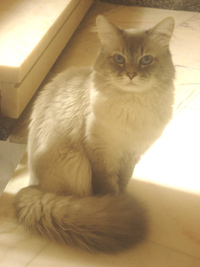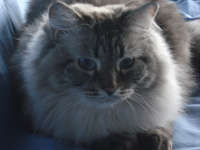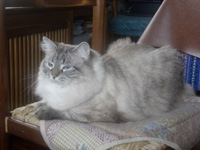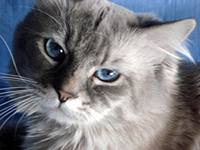 |
Siberian Cat
Origins
Physical structure The Siberian cat body develops itself rather slowly. In fact it grows to an adult appearance only towards the age of 4 or 5. The Siberian cat has a brawny physique, with a medium-large build, the male, in particular, is bigger and more powerful. The body features transmit a roundness feeling. The back is slightly bent, but the curvature is little evident when the animal is in motion. Head The shape of the head is delicately rounded and it's nicely proportioned to the rest of the body. The upper body is flat. The nose, wide between the eyes, is shrunk towards the extremity and it shows a small curving. Neck It's not long, but wide and muscular. Ears
Eyes
Chin Developed but not protruding. Tail The tail is of a medium length; when laying along the flank, it arrives approximately until the scapulas. Wide and sturdy, rounded off on the tip. The fur on the tail is thick also in summer. Legs Legs are well proportioned with a strong skeleton. They are of medium length and the back legs are a little longer than the front ones. The feet are large, round and between the fingers they have abundant hair forelocks (given the cat origins, this is to avoid sinking in the snow). Fur Coat 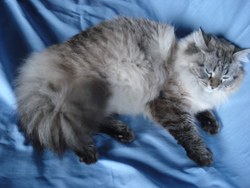 The Siberian Cat is part of medium long hair category of cats. The fur is short on the back of the head and on the shoulders. It's waterproof, equipped with a layer of fat, in order to adapt itself to the typical rigid climate of the country of origin. However the hairs are not oily, indeed this characteristic avoids knots, therefore the coat care is easy.
The Siberian Cat is part of medium long hair category of cats. The fur is short on the back of the head and on the shoulders. It's waterproof, equipped with a layer of fat, in order to adapt itself to the typical rigid climate of the country of origin. However the hairs are not oily, indeed this characteristic avoids knots, therefore the coat care is easy.In winter the undercoat grows thicker, the fur gets longer and an hairs collar grows around the neck. In summer the Siberian loses its winter coat. The Siberian fur is very particular (hypoallergenic) and it is tolerated by people normally allergic to it. The allergy is provoked by the FEL D1 protein produced by the sebaceous glands. In the United States some studies have showed how the FEL D1 protein production is nearly null in the Siberian Cat. For this exact reason the Siberian is advised in cases of animal hairs allergy. All the traditional fur colours (blue, red, cream, tortie, black , silver, smoke) are allowed with the exception of the chocolate varieties, lilac, cinnamon and fawn. The colours can be solid or diluted, any amount of white is admitted and in any part of the body; the white does not have to be distributed in an exact proportion. The "color point" cat is named "Neva Masquerade". Character and temperament The Siberian Cat wants to feel himself a part of the family and wishes your attentions. It does not import in which room you are, it will follow to you because he looks for your company. It will place itself close to you while you're watching TV, he will squat dawn on the table while the children are doing their homework and he will receive you in the morning as you wake greeting you with a characteristic sound that seems a mixture between mewing, fused and twittering. When you are becomes ill, he will squat down side by side to you at the end of the bed and will not leave you. Persons who have a Siberian cat often compares its with a dog : Siberian is very affectionate, intelligent, gentle and very quick learners. The Siberian Cat is affectionate with the owners and often he shows its preference towards one person in particular. He is in generally a tolerant and patient animal and therefore adapted to the children and the presence of dogs or other cats. The females are loving mothers, extremely careful to every movement of the own sons and they completely dedicate themselves to their care. The Siberian Cat amuses itself to play with little: one rolled up candy paper, a rolled up piece of scotch, one old belt to capture. It has got an amazing agility and if there is a cat-tree it will amuse to scramble up and to complete spectacular leaps. Obviously it needs of the right amount of break. Usually this happens in the morning or in the afternoon when its landlady is out of house to work. It mews rarely and only for necessity. |
